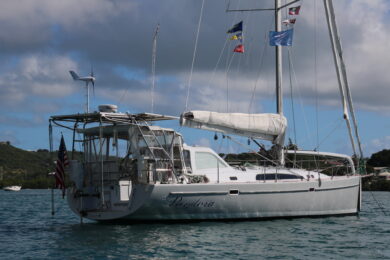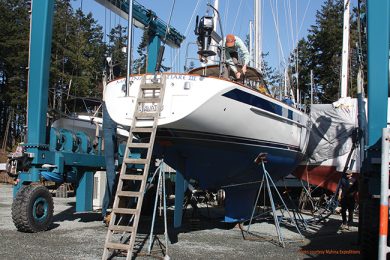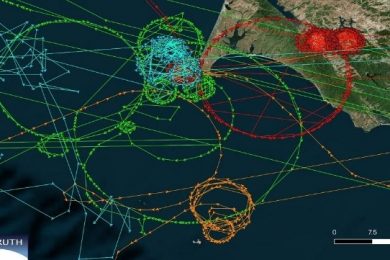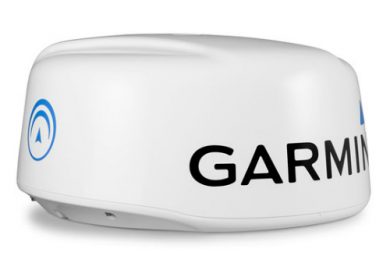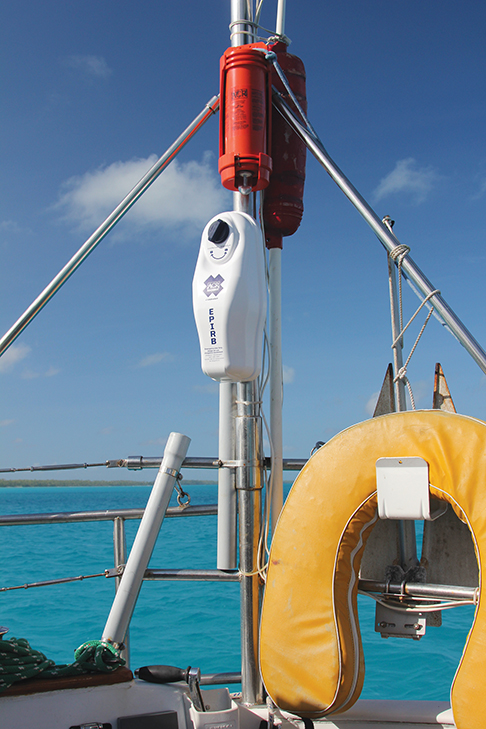(published February 2012)
We had just settled back on the anchor in a protected coral cove after a stormy ocean passage. I glanced out the companionway to see not a sunset, but a faint disc being smothered into darkness. No green flash tonight, but there was the muffled flash of a strobe light in the cockpit. Holy moly—the EPIRB was going off!
I raced up the companionway stairs and grabbed the EPIRB from its protective housing. But how to make it stop flashing? Patrick quickly palmed a screwdriver and removed four screws holding the EPIRB together to get to the battery. Then we scrambled to follow the steps necessary to make sure a rescue plane would not soon be flying overhead.
In the EPIRB manual under “False Alarms,” we were directed to contact the emergency coordinating center where the EPIRB was registered. In our case, this was the United States. But we were in the middle of the Pacific, where telephones don’t exist. We sent an email over SSB radio to three friends, containing our EPIRB’s 15-digit unique identifier number (UID), the date and time of the transmission, where we were located—and the fact that there was no emergency. Luckily, my father received our message immediately and made the calls as quickly as his fingers could dial. Additionally, we notified the SSB net, with which we had been in frequent contact, that Brick House had a possible false EPIRB activation but all was well on board.
I’m not sure how long our EPIRB was going off, but Coast Guard records never showed a signal from us. There is a chance that we managed to deactivate the EPIRB within the 90-second grace period. We also quickly removed the antenna and brought the EPIRB inside the cabin, which would have degraded the transmission. Additionally, we may have inadvertently dried the moisture that produces continuity across two pan screws on the left side of the housing. At the time, we were unaware those two screws are the water-sensing switch.
SELF-TESTING
Months later, upon reaching a postal system, we shipped the EPIRB to ACR Electronics for some answers. When ACR received the unit, they were not impressed with our reassembly efforts. EPIRB manufacturers aren’t kidding when they say there are no user-serviceable items inside the unit.
The problems found were mostly to do with lack of maintenance. We never did the required “monthly self-test,” which would have told us something was failing in the unit. Such a vital piece of equipment needs to be removed from its bracket, handled and checked on a regular basis. There is a story of a yacht owner who slipped into a rescue situation, quickly peeled the wrapping from the box, and removed his brand new EPIRB and instruction manual. He eventually figured out how to manually activate the beacon, but rescue did not happen quickly because he was viewing the blank registration forms for the first time.
Once a month, the activation switch should be lifted to the vertical position to activate the self-test (the switch can be lowered to its original position while the test continues). Moving the switch fully to its opposite position will activate the EPIRB and scramble the cavalry. The new ACR self-tests go out to stationary satellites monitored by NOAA, where the coded test signal is ignored. ACR can also pick up those test messages with their own satellite ground stations. An LED screen on the EPIRB lights up with a checkmark as each phase of the test is passed. The test is completed in eight or nine seconds and then the unit automatically shuts down. The LED screens on the new units are handy both for the test and for a real activation—instead of sitting in a life raft wondering about the blinking EPIRB, you will have visual communication in English (or four other languages) that it’s actually working.
The second round of self-testing queries the internal GPS. The acquiring capability of most EPIRBs is fast—usually within 30 seconds. Yet the test shuts off automatically if the GPS does not obtain a position within two minutes in order to save battery life. Some ACR units allow an external GPS to be optically connected to the EPIRB so lat/lon can be updated every 20 minutes without disturbing the battery of the EPIRB. This is simply an extra.
The monthly tests of ACR units (60 tests are allowed in five years) use less than 1% of the total battery capacity. The five-year life of the battery is just a fraction of its “shelf life,” so there is a lot of battery security built into each EPIRB. With the newest energy-saving technology utilizing LEDs instead of the higher energy strobes in earlier models, and other advanced circuitry, most newer EPIRBs can easily transmit longer than their stated 24- or 48-hour rated lives.
 EXAMINATIONS AND INSPECTIONS
EXAMINATIONS AND INSPECTIONS
Every few months, the float-free mounting bracket and beacon should be examined for deterioration or residue buildup that may affect the beacon or release mechanisms. The antenna should be checked for tightness and deterioration. Wipe off any salt or spider webs that have accumulated using a soft, damp cloth with rubbing alcohol.
Examine the area of the Category 1 bracket where the magnet is located, looking specifically for any cracking or deterioration and for a tight fit between the EPIRB and the magnet. As long as that magnet stays within 1/8 of an inch of the EPIRB, it will hold open a switch that will keep the EPIRB from activating even if the EPIRB is thoroughly wet. If an EPIRB held in a bracket is wet, dry it off (especially the two screws on the left side of the unit). Continue an inspection of the bracket by looking for cracks in the case or EPIRB itself. If any are found, those items should be sent in for repair.
After five years of service on our boat, we brought our EPIRB to a station in Panama to have the battery replaced. With commercial use, the battery is required to be replaced every five years. There is no mandatory replacement for leisure use. Panama being Panama, they didn’t inform us that we should have brought the entire Category 1 bracket in for inspection, since the bracket is as much a part of the system as the EPIRB itself. Also, although our antenna was severely deteriorated at that time, they only told us the obvious: holding an EPIRB by the antenna will lead to degradation and breakage of the antenna. It was clear we needed a new antenna, but there were none of the prescribed length immediately available. We later learned a similar length antenna would have worked, but not optimally.
 If we had brought our Category 1 bracket into the Panama service center, they would have noticed that the hydrostatic release mechanism, which deploys the EPIRB upon sinking, was long expired. This device is designed to feel a certain amount of pressure when it is submerged between four and 14 feet of water (depending on water temperature). When this pressure occurs, the unit’s internal spring sends a sharp blade severing the long black plastic retaining pin. At the same time, the wide flat ejector spring snaps forward, throwing the EPIRB out of the bracket. Because the EPIRB’s exposed top screws are now wet and the bracket’s magnet is no longer holding the internal switch in check, the EPIRB activates. The hydrostatic release is only guaranteed to work for two years. After that, it may not eject the unit from the bracket, and your EPIRB may just go down silently with the boat. Your “best last chance” just became your last bit of bad luck.
If we had brought our Category 1 bracket into the Panama service center, they would have noticed that the hydrostatic release mechanism, which deploys the EPIRB upon sinking, was long expired. This device is designed to feel a certain amount of pressure when it is submerged between four and 14 feet of water (depending on water temperature). When this pressure occurs, the unit’s internal spring sends a sharp blade severing the long black plastic retaining pin. At the same time, the wide flat ejector spring snaps forward, throwing the EPIRB out of the bracket. Because the EPIRB’s exposed top screws are now wet and the bracket’s magnet is no longer holding the internal switch in check, the EPIRB activates. The hydrostatic release is only guaranteed to work for two years. After that, it may not eject the unit from the bracket, and your EPIRB may just go down silently with the boat. Your “best last chance” just became your last bit of bad luck.
Placement of the Category 1 self-deploying bracket, is important. Sailboats tend to sink level or slightly bow down, so mounting needs to be concerned with awnings and obstructions that could keep it from floating free from the yacht. Brackets should also be sheltered from breaking waves. A Category 2 manual release holder should be mounted in an accessible, dry location.
 TWO ARE BETTER THAN ONE
TWO ARE BETTER THAN ONE
Technology has come a long way, so we decided to invest in the redundancy of two new EPIRBS. One is a Category 1 cockpit-mounted ACR Globalfix iPro/RLB-36 unit. The other is an ACR Aqualink View/PLB-350C Personal Locator Beacon (PLB) for our ditch bag.
If our sturdy boat should ever go down, it would most likely be a sudden and wild event. We may not have the time or presence of mind to do what a self-deploying EPIRB will automatically do for us. Redundant to that system is the PLB. The PLB is a physically smaller EPIRB with a battery operating life of at least 24 hours. The PLB must be registered just like an EPIRB. The PLB is manually activated by pressing the activation button for one full second; water contact does not automatically activate it. Like any EPIRB, the antenna and GPS receiver of the PLB must be above water and have a clear view of the sky.
In very bad weather, there are times we slip the PLB into a secure foul weather jacket pocket just in case of a man overboard situation. The PLB could help those on a yacht locate the man in the water if the PLB’s coordinates can be obtained from SAR. Since the signal sent from a PLB is coded so rescue centers know it is a PLB and not an EPIRB, PLBs are allowed to be carried on private aircraft or by individuals hiking in remote areas. One day, PLBs will have AIS transponder capability so a person in the water can be seen as an icon on a yacht’s AIS display. That cool technology is just this side of the horizon.
Crossing oceans or in a calm harbor, our EPIRBS are no longer the “install and forget” electronics they once were, but rather our much cared for “best last chances.”
World cruisers Rebecca and Patrick Childress are now happily exploring remote Pacific islands and beyond.
Making Yourself Known
One thing we did correctly was register our EPIRB immediately after purchasing it. Response to an activated EPIRB can be greatly delayed if it is not registered. Registration forms that can be mailed or faxed to the authority at NOAA come with each EPIRB, but it is easier to register online at www.beaconregistration.noaa.gov. Every two years, registration information must be updated. Non-U.S. owners should register their EPIRBs with their own country’s national authority; however, many foreign countries rely on registration through an international database (www.406registration.com).
Many EPIRB owners aren’t aware of the bonus of the “additional data” box on the registration form. You can make it known ahead of time that someone is hard of hearing or has medical conditions or allergies. You could even provide your blog or website so searchers have pictures of the boat. Any information that would be helpful in a rescue situation can be updated at any time. You can also provide emergency contact information on this form. Only list someone who would know your approximate whereabouts, and can provide intelligent information about the yacht.
Key Emergency Contacts
510-437-3700 (Pacific Ocean USCG Command Center)
1-800-323-7233 (USCG Headquarters Command Center)
757-398-6390 (USCG Atlantic Area Command Center)









